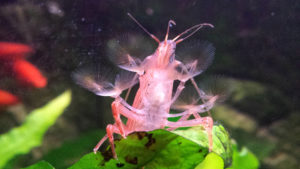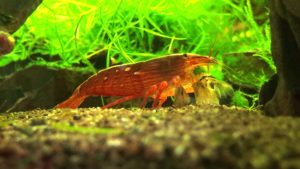12 Jul BAMBOO SHRIMP – Atyopsis Moluccensis – facts info
Name and family:
Atyopsis Moluccensis or Atya commonly called Shrimp Radar, Shrimp Shrimp, Moluccas Shrimp. It is a common freshwater crustacean and comes from the Atydae family.
In nature comes from the area of Indonesia.
Feature and behavior:
The filter shrimp has an elongated shape with dark red-brown colorings with a clearer dorsal strip. It has six pairs of antennas, bright eyes positioned on the head and the typical four fans in place of chele that uses to filter out the water micro food particles that then comes to the mouth. To move, he uses his paws but also has micro propulsors that facilitate the swim. Its growth will be accompanied by a loss of the old shell, and it performs the mud as almost all the crustaceans. It will not be rare to find in his aquarium his old skin. Of this particular shrimp there are several species all very similar to each other and are: Atyopsis Gabonensis, Atyopsis Spinipes, Atya Camerunensis, Atya Lanipes. It really likes to stay near the water flow areas because right there that filter the water in better way.
Fishes’s coexistance:
The radar shrimp is a very peaceful crustacean and adapts well to community aquariums. It is advised, being a sheepdog and as such should be included in no less than 4/5 specimens. Bear in mind that great predators such as Ciclidi or Barbi could identify it as prey but often the large size of this crustacean dissuade these great fish. It is very important and advisable to not put it in aquariums without cover because can climbing and escape.
Sexual dimorphism and breeding:
Sexual dimorphism between male and female is almost imperceptible. The only details are the larger size of the male and the hooks on the front legs of the latter used to cling to the female during the coupling.
Reproduction, though very difficult in the aquarium, occurs through a gestation of 30 days and you will have to raise the temperature in the aquarium at 26 ° C.
Feeding and mantenance:
The feeding of this omnivorous shrimp basically occurs in two ways: the first, most famous, is to open its fans in favor of the current and wait for some particles that will lead to the mouth. The second method is to stay on the bottom and bring the gravel into the mouth with the fans and rescue it clean from the small particles naturally present here. It is therefore advisable not to give food to this shrimp because it will provide for itself.
Price:
8 euros.



 English
English Italiano
Italiano